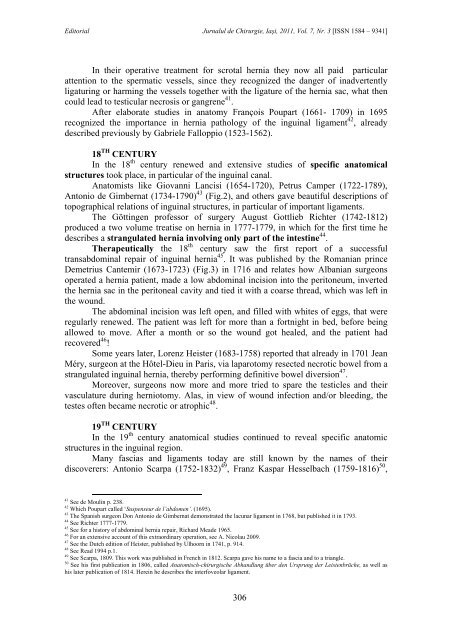PDF (10 MB) - Jurnalul de Chirurgie
PDF (10 MB) - Jurnalul de Chirurgie
PDF (10 MB) - Jurnalul de Chirurgie
You also want an ePaper? Increase the reach of your titles
YUMPU automatically turns print PDFs into web optimized ePapers that Google loves.
Editorial <strong>Jurnalul</strong> <strong>de</strong> <strong>Chirurgie</strong>, Iaşi, 2011, Vol. 7, Nr. 3 [ISSN 1584 – 9341]<br />
In their operative treatment for scrotal hernia they now all paid particular<br />
attention to the spermatic vessels, since they recognized the danger of inadvertently<br />
ligaturing or harming the vessels together with the ligature of the hernia sac, what then<br />
could lead to testicular necrosis or gangrene 41 .<br />
After elaborate studies in anatomy François Poupart (1661- 1709) in 1695<br />
recognized the importance in hernia pathology of the inguinal ligament 42 , already<br />
<strong>de</strong>scribed previously by Gabriele Falloppio (1523-1562).<br />
18 TH CENTURY<br />
In the 18 th century renewed and extensive studies of specific anatomical<br />
structures took place, in particular of the inguinal canal.<br />
Anatomists like Giovanni Lancisi (1654-1720), Petrus Camper (1722-1789),<br />
Antonio <strong>de</strong> Gimbernat (1734-1790) 43 (Fig.2), and others gave beautiful <strong>de</strong>scriptions of<br />
topographical relations of inguinal structures, in particular of important ligaments.<br />
The Göttingen professor of surgery August Gottlieb Richter (1742-1812)<br />
produced a two volume treatise on hernia in 1777-1779, in which for the first time he<br />
<strong>de</strong>scribes a strangulated hernia involving only part of the intestine 44 .<br />
Therapeutically the 18 th century saw the first report of a successful<br />
transabdominal repair of inguinal hernia 45 . It was published by the Romanian prince<br />
Demetrius Cantemir (1673-1723) (Fig.3) in 1716 and relates how Albanian surgeons<br />
operated a hernia patient, ma<strong>de</strong> a low abdominal incision into the peritoneum, inverted<br />
the hernia sac in the peritoneal cavity and tied it with a coarse thread, which was left in<br />
the wound.<br />
The abdominal incision was left open, and filled with whites of eggs, that were<br />
regularly renewed. The patient was left for more than a fortnight in bed, before being<br />
allowed to move. After a month or so the wound got healed, and the patient had<br />
recovered 46 !<br />
Some years later, Lorenz Heister (1683-1758) reported that already in 1701 Jean<br />
Méry, surgeon at the Hôtel-Dieu in Paris, via laparotomy resected necrotic bowel from a<br />
strangulated inguinal hernia, thereby performing <strong>de</strong>finitive bowel diversion 47 .<br />
Moreover, surgeons now more and more tried to spare the testicles and their<br />
vasculature during herniotomy. Alas, in view of wound infection and/or bleeding, the<br />
testes often became necrotic or atrophic 48 .<br />
19 TH CENTURY<br />
In the 19 th century anatomical studies continued to reveal specific anatomic<br />
structures in the inguinal region.<br />
Many fascias and ligaments today are still known by the names of their<br />
discoverers: Antonio Scarpa (1752-1832) 49 , Franz Kaspar Hesselbach (1759-1816) 50 ,<br />
41 See <strong>de</strong> Moulin p. 238.<br />
42 Which Poupart called ‘Suspenseur <strong>de</strong> l’abdomen’. (1695).<br />
43 The Spanish surgeon Don Antonio <strong>de</strong> Gimbernat <strong>de</strong>monstrated the lacunar ligament in 1768, but published it in 1793.<br />
44 See Richter 1777-1779.<br />
45 See for a history of abdominal hernia repair, Richard Mea<strong>de</strong> 1965.<br />
46 For an extensive account of this extraordinary operation, see A. Nicolau 2009.<br />
47 See the Dutch edition of Heister, published by Ulhoorn in 1741, p. 914.<br />
48 See Read 1994 p.1.<br />
49 See Scarpa, 1809. This work was published in French in 1812. Scarpa gave his name to a fascia and to a triangle.<br />
50 See his first publication in 1806, called Anatomisch-chirurgische Abhandlung über <strong>de</strong>n Ursprung <strong>de</strong>r Leistenbrüche, as well as<br />
his later publication of 1814. Herein he <strong>de</strong>scribes the interfoveolar ligament.<br />
306

















